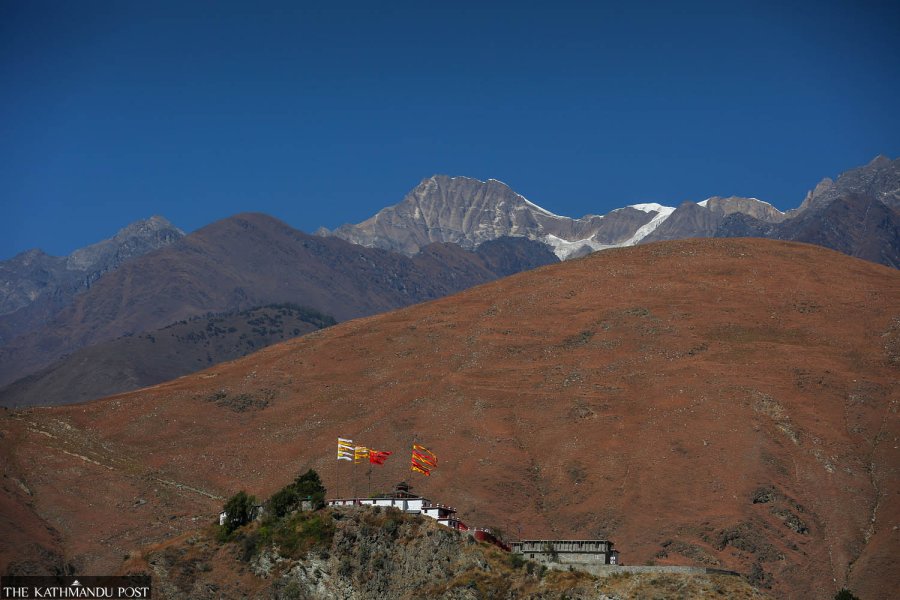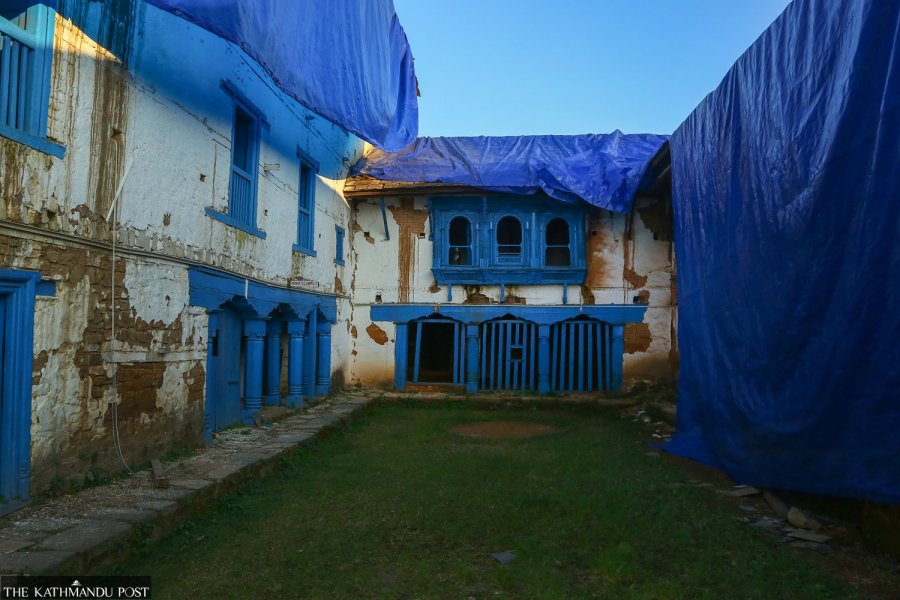December 18, 2024
KATHMANDU – After my first trek to Langtang last year, I promised to trek to a new destination every year. Even though I couldn’t keep that promise, I tagged along with my father and his colleagues on a work trip to Dolpa. As we prepared for the journey, my father said, “I am taking you along only if you promise to stay awake the entire way and not fall asleep.”
Our first stop was Chinchu, a junction point where the road splits: one leads to Kohalpur and the other northeast along the Bheri River. We continued northeast, and from that point, the glacial-fed Bheri River became our constant companion until we reached our destination, Dolpa.
By the time we reached Jajarkot, it was already dark, but we could still see remnants of houses destroyed in the 6.4 magnitude earthquake of November 2023.

Passengers ride atop a jeep on the rugged road leading to Dolpa. PHOTO: THE KATHMANDU POST
The following day, we reached the Jajarkot Durbar, now the District Administration Office. According to the locals, when Nepal was divided into the Baisey and Chaubisey Rajya, the red durbar was constructed before 1800 BS by King Hari Shah, the 14th King of Jajarkot. Later, in 1852, the 16th King of Jajarkot, Indra Narayan Shah, built the white durbar. These durbars were constructed by the locals of Jajarkot, who laboured free of charge.
After a quick lunch at Tallobagar, we continued on our journey. The day was short, but the night stretched endlessly before us. We planned to reach Dunai, the municipality of Dolpa, early enough to enjoy the scenic view, but the bumpy road ahead made it impossible.

The Bheri River and the Tripurakot village as seen from the Tripura Sundari temple. PHOTO: THE KATHMANDU POST
A little ahead, we crossed a bridge that collapsed two years ago, killing four people. Once across, we began the five-hour bumpy ride to Dunai. The walls had political slogans, and nearly every house displayed flags of political parties that they were affiliated with. Almost peculiar for us was the sight of women whose heads were covered with a red turban, under which money was tucked. When we asked her about it, she explained that she had just returned from her maternal home after Bhai tika, and the money tucked into her turban was given to her by her brother. “It is our tradition,” one of them said.
After two hours of driving, we reached Triveni, the confluence point of three districts: Rukum, Dolpa, and Jajarkot. We reached Dunai at 7 pm.

Landscape view of Tripura Sundari. PHOTO: THE KATHMANDU POST
My father woke me up at 5 am to prepare for our next destination, the Tripura Sundari temple. The route to the temple was a memorable one. The gurgling Bheri River looked beautiful in its deep blue hue, contrasted beautifully with the surrounding brown hills.
The temple’s red, blue, and yellow fluttering flags, visible from the road, invited us to the temple. Located at an elevation ranging from 2,000 meters to 5,000 meters, the temple is situated near Tripurakot on the bank of the Thuli Bheri River. According to legends from the Shri Swasthani, the temple was named Tripura Sundari because a demon Tripura was killed there. It is also believed that Sati Devi’s torso fell at this spot, making it sacred.

Seto Durbar in Jajarkot, currently serving as the District Administration Office, is undergoing construction. PHOTO: THE KATHMANDU POST
Recounting the mythology of the temple’s history, one of the priests, Laxmi Kanta Upadhayaya from the temple, said King Bikram Sahi had built the Tripura Kot fort in the 7th century. The rice milling machine of the fort would yield eight maanas of rice while milling four. Even the chaff from milling would turn into rice. After excavating where the rice mill was kept, a copper vessel was uncovered, with a pan of ghee placed above it and, above the pan, a copper plate. On top of the plate was a Sastkona Yantra (a mystical six-pointed diagram), and inside the layers, butterflies representing the nine forms of goddess Navadurga Bhawani were discovered.

The road to Triveni passes alongside a cliff. PHOTO: THE KATHMANDU POST
Just after that, the leader of the excavation, Kaji, fainted and began to speak, as I was told, under the influence of the goddess’s divine power, where he said, “We are the nine sisters, Bhagwati. As butterfly-formed goddesses, we have flown and settled in various places. Among us are Bageshwari of Banke, Kanika Sundari of Jumla, Khairabang Devi of Salyan, Ganasaini Tripureshwari of Baitadi, and Badimalika of Bajura. The remaining four sister goddesses, Bala, Tripura, and Sundari, reside in Tripura Sundari of Dolpa.”
After receiving blessings, we were on our way back to Kathmandu via the Madhya Paschim Highway. We reached West Rukum at night, and the following day, on our way to East Rukum, we stopped the car to take photos of the stunning landscape of West Rukum. Surrounded by the towering hills of East Rukum, the vastness before me had flat areas with sloped land for growing crops. The land was dotted with patches of green and sparsely distributed houses with colourful roofs that made the place look spectacular.
After descending, we drove towards Baglung. The landscape shifted, with dense forests of coniferous trees carpeting the hills. The trees stood at the hills in a pattern reminiscent of a traditional Nepali carpet. In this way, travelling through three provinces–Karnali, Lumbini, and Gandaki, and covering nearly seven districts, we concluded our trip in five days.


